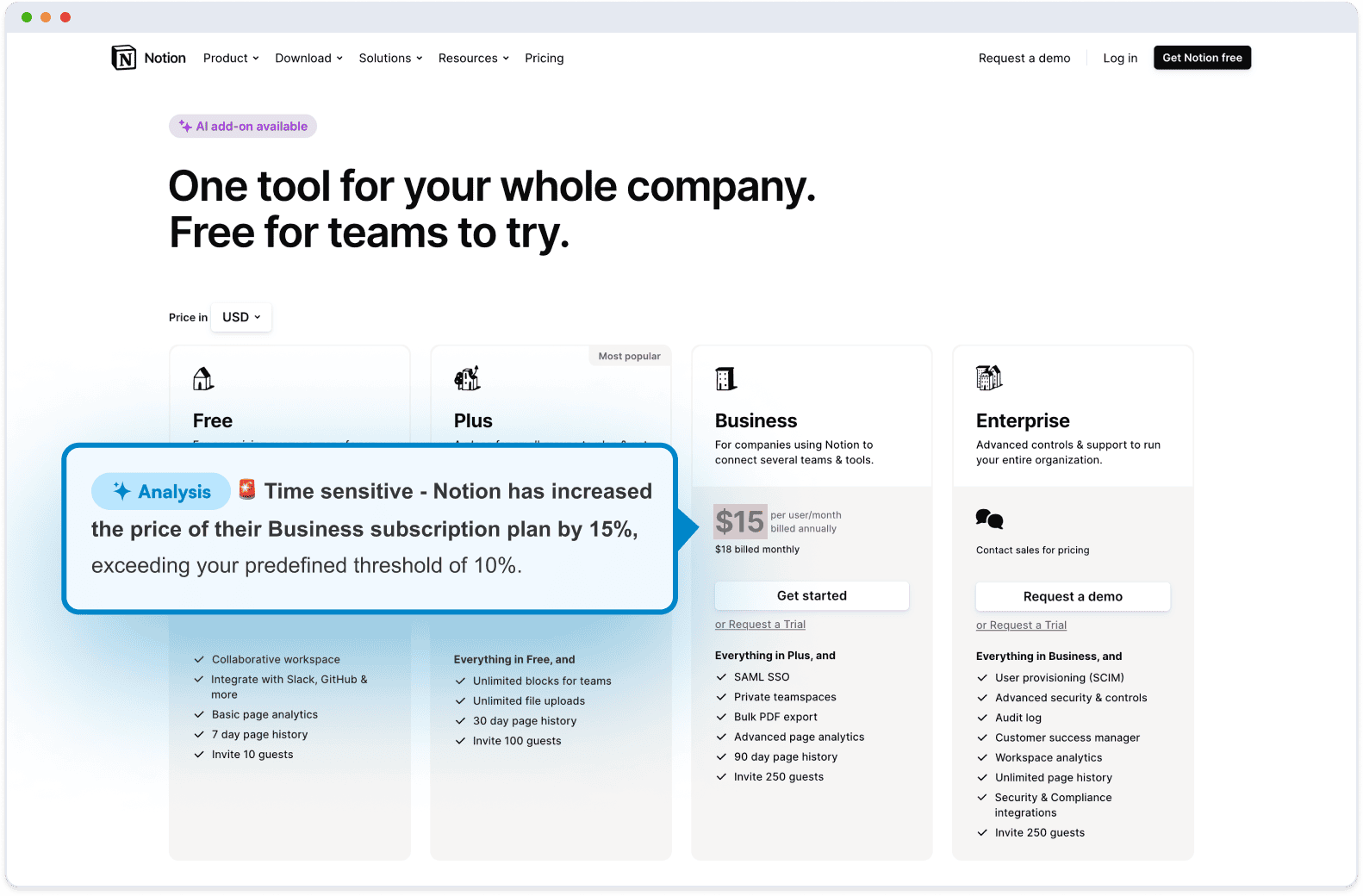How to Conduct a Competitive Pricing Analysis
By Emily Fenton
Updated August 26, 2025

Introduction
One of the most important aspects of competitive intelligence that can set you ahead of your competitors is pricing.
Competitive pricing analysis, or the process of understanding your competitors' pricing strategies, is essential for businesses to make informed pricing decisions. It involves gathering and analyzing competitor pricing data to guide smarter decisions about your own pricing strategy.
Especially in saturated markets where even small price differences can sway customer decisions, monitoring competitors’ pricing shifts and responding strategically allows businesses to strengthen their market position and uncover new opportunities for growth.
In this post, we’ll dive into what competitive pricing analysis is, why it's important, issues with some of today’s most mainstream approaches, as well as some tips and tricks to get started with conducting your own competitive pricing analysis using Visualping.
What is a Competitive Pricing Analysis?
Competitive pricing analysis is the study of how your competitors price their products and services, and how those compare to your own.
This process involves collecting and analyzing price data from rival companies to identify market trends and pricing patterns.
When do competitors run sales? When do they raise prices? Competitive pricing analysis helps you track these shifts and respond strategically.
While all types of businesses can benefit from this analysis, it’s particularly important in markets with high sales volumes where similar products are being sold.
For example, retailers regularly monitor competitors’ prices to ensure their own offerings remain competitive, especially since online prices can fluctuate frequently.
Gianluca Ferruggia, General Manager at DesignRush, a B2B marketplace connecting businesses with agencies, emphasizes the importance of focusing competitive intelligence efforts specifically on pricing when starting out.
“Rather than attempting to scan for everything, you should think about the one or two areas where intelligence is likely creating the greatest impact like pricing changes, product launches or new competitors starting to emerge,” she said.
“Build a repeatable process for those areas, measure the impact of your insights, and grow your strategy over time.”
By starting with pricing metrics, businesses can create a manageable competitive pricing analysis process that delivers meaningful insights without being overwhelmed by data.
Why Competitive Pricing Analysis Matters

Competitive pricing analysis gives businesses tangible insights into market trends and consumer behavior, and allow them to make smarter, more informed pricing decisions.
By analyzing pricing data, businesses can identify patterns, understand customer preferences, and adjust their strategies accordingly.
Data-driven pricing decisions perform better than guesswork. Companies that analyze competitor rates can choose between different approaches like penetration pricing for new markets or dynamic pricing that changes with demand.
This information helps businesses understand key pricing factors beyond just cost. Market position, customer expectations, and competitor moves all influence what price works best.
At the end of the day, pricing strategies become much more effective when businesses know what the competition offers. Smart companies use this data to find the right balance between profit and customer appeal.
With many competitive intelligence tools out there, it can be hard to know where to get started. Visualping is an easy-to-use, but powerful competitive intelligence tool that allows businesses to track competitor pricing and website changes in real time.
When a competitor changes their pricing, Visualping sends businesses an email alert that includes an AI-generated summary of the change, distilled in two to three lines, so you can quickly understand what happened. It also includes a screenshot of the page, with the changes highlighted.

By receiving instant notifications whenever there are pricing changes in the market, businesses can conduct competitor price tracking and adapt their own pricing strategies immediately, ensuring they're always getting the most up-to-date data to inform their business decisions.
Challenges with Running Competitive Pricing Analysis
Businesses face an uphill battle when starting their competitive pricing analysis efforts. Gathering and analyzing data can be time-consuming and difficult to stay on top of. Some challenges include:
Manual Tracking
Companies that manually collect pricing data encounter numerous problems that affect their market research quality. This approach requires staff to visit competitor websites, record prices in spreadsheets, and track changes over time.
Manually tracking competitor prices can be time-consuming and prone to errors, and often provides only a limited view, since teams can’t monitor enough competitors to capture the full market picture.
These conventional methods often fail to provide real-time insights as prices can change quickly in many industries. Yesterday's information isn't valuable for current decisions.
Manual tracking also lacks consistency. Different team members may interpret pricing information differently or miss important details like shipping costs or promotional offers. This inconsistency makes it difficult to perform accurate competitor analysis.
Especially with the availability of competitor monitoring tools, which can automate this process for you, tracking competitors’ prices manually is considered time-consuming, ineffective and ultimately more costly than investing in an automated competitor tracker.
Generic Competitive Intelligence Software
While many businesses may turn to software solutions for competitor analysis, generic platforms also present their own challenges. Often times, these tools often come with features that companies don't really need or use effectively.
Most industry standard competitive pricing software have garnered somewhat of a reputation for being expensive and dense with overly complicated and specialized functionalities.
And so, when evaluating the many different options out there, it’s important to first identify your team’s goals, and review your options relative to those goals.
This is why Visualping is one of the most popular competitive pricing trackers. It’s more affordable than most industry standard tools, and its methodology is simple: simply enter the web pages you want to track for updates, and Visualping will notify you of changes.
Visualping is the leading AI website monitoring software that allows you to monitor any web pages on the internet for changes. You can use it to track competitors' websites for changes, such as key pricing and product web pages, or use it to track marketplaces where your competitors post their prices.
When a change is detected on a page you're tracking, Visualping sends you an email alert, with an AI-generated summary of the change, distilled in two to three lines. It also includes a screenshot, with the changes highlighted.

With Visualping, businesses have the scalability and agility necessary for effective competitive pricing analysis. It’s the top solution for teams looking to keep an eye on competitors’ pricing changes, from literally anywhere on the web.
How to Conduct a Competitive Pricing Analysis with Visualping
Step 1: Enter the URL into Visualping's homepage
To track your competitors, open the desired webpage on your browser and copy the URL from the address bar. Then, open up the Visualping homepage and paste the URL into the provided search field.
The web page will appear in Visualping’s viewfinder.
Step 2: Select the Page Section for Monitoring
Next, select the specific area of the page you want to receive updates on. You can select the area, specific web page elements, or even the whole webpage.
Step 3: Set Up Important Alerts
While Visualping will monitor for any change on the selected area, using the AI Summaries field, you can set specific criteria for what counts as an 'important’ alert. These alerts are highlighted in your inbox so they stand out.
For example, you could enter: ‘Notify me of any price changes on this product page.’
Step 4: Set the Monitoring Frequency
Specify how frequently Visualping should check the page for changes. Adjust the interval based on your preference, ranging from as frequently as every five minutes to as long as every month.
Step 5: Provide Email for Notification Delivery
Next, enter the email address you would like your change alerts sent to.
As a last step, after you click “Start Monitoring”, you will receive an email prompting you to confirm your account – do not skip this! In order to receive alerts on your competitors, you need to confirm your account.
Conclusion
Smart pricing analysis tools help businesses stay ahead in tough markets. Companies need real-time data to make quick pricing changes when competitors adjust their rates. Check out Visualping, a no-fuss competitive price tracking tool.
Interested in finding out more about how your team can use Visualping for your competitive pricing strategy? Contact us today – our support team would be happy to help.
Frequently Asked Questions
What is a competitive pricing analysis?
A competitive pricing analysis is the process of researching and analyzing the pricing strategies of your competitors. It involves gathering their pricing data to understand market trends, identify patterns (like when they run sales or raise prices), and compare their prices to your own to make more informed and strategic pricing decisions.
Why is competitive pricing analysis important for a business?
Competitive pricing analysis is important because it provides tangible, data-driven insights that are more effective than guesswork. By understanding the competitive landscape, businesses can:
- Strengthen their market position, especially in saturated markets.
- Identify new opportunities for growth.
- Make smarter decisions on pricing strategies, such as penetration or dynamic pricing.
- Find the right balance between profitability and customer appeal.
What are the common challenges of conducting a competitive pricing analysis?
- Manual tracking: Manually visiting competitor websites and recording prices is time-consuming, prone to human error, lacks real-time data, and often provides an incomplete picture of the market.
- Generic competitive intelligence software: Many software solutions are expensive, overly complicated, and include features that businesses don't actually need, making them difficult to use effectively.
Visualping: competitor monitoring made simple
Get targeted updates from the competition on autopilot. Trusted by 85% of Fortune 500 companies.
Emily Fenton
Emily is the Product Marketing Manager at Visualping. She has a degree in English Literature and a Masters in Management. When she’s not researching and writing about all things Visualping, she loves exploring new restaurants, playing guitar and petting her cats.